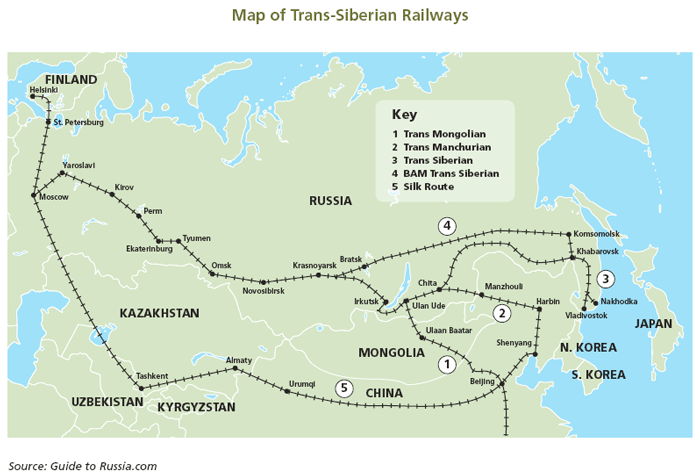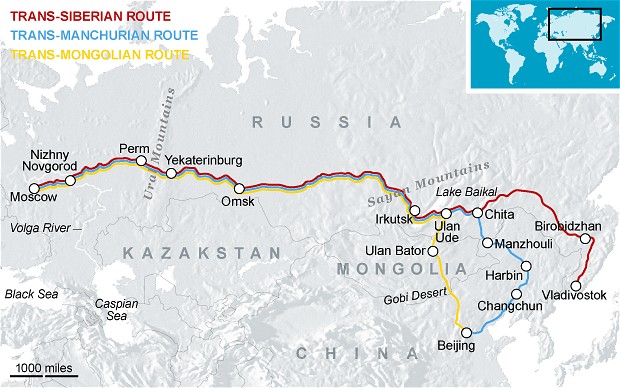


Irkutsk: Here is where you’ll find the famous Lake Baikal, which is a must-see on your Transsiberian Railway trip.
#TRANS SIBERIAN RAIL ROUTE FULL#
Recommended stay: 2 nights (to give you a full day of hiking at the park) Spend a day hiking in Stolby National Park with epic views and few tourists. Krasnoyarsk: A great stop if you’re interested in hiking. Recommended stay: 2 daysĮkaterinburg: Catch sunset from the top of the Vysotsky skyscraper, visit the border between Europe and Asia (put one foot in each continent!), explore Ganina Yama monastery in the forest, and spend some time wandering the lively city center. Kazan: Be sure to visit the beautiful blue Kul Sharif Mosque, the colorful Temple of All Religions, and catch sunset from Kremlin.

Definitely give yourself a few days to explore this city! There is so much to see in terms of art/music/theater, excellent food, impressive architecture, and beautiful parks. Moscow: This is where you’ll “officially” start your Transsiberian Railway journey. You can then take a train to Moscow where you will transfer to the Transsiberian train. Petersburg: This city is technically not a part of the official Transsiberian Railway route, but if you’ve put in all this effort to get your Russia visa and to fly over there, you might as well stop at the most beautiful city in Russia! Spend a few days indulging in the impressive culinary scene, visiting the beautiful churches, and wandering the streets of this stunning historic city.
#TRANS SIBERIAN RAIL ROUTE WINDOWS#
You have a chance to experience a real adventure and cross the whole country starting in Moscow, pass through the breathtaking European part of Russia, see the deepest lake in the world - Lake Baikal and the Ural Mountains separating Europe and Asia, cross the mighty 2 km-long Amur Bridge, pass the 7 km-long tunnel that goes under the Amur River, see the only train station in the world built completely out of marble, span further into Siberia’s beautiful taiga and steppes, and arrive in Vladivostok - the Russian Far East port located on the Pacific Ocean!Īpart from the appealing scenery from the train windows the trains alone are a unique atmosphere where travelers can see Russian culture inside out, get to know passengers each with their own story, observe the genuine Russian style of life, and even take part of it if desired! You will be impressed by the great cities and awed by the rural fairy tale villages, sigh with delight from the wilderness of the Ural Mountains, forests of Krasnoyarsk, and the awe-inspiring Lake Baikal.Here is a recommended itinerary for about a month-long Transsiberian Railway trip: The Trans-Siberian Railway together with Trans-Siberian tours is indeed the best way to explore Russia’s diverse landscapes and its rich natural and man-made heritage! It provides you with a wealth of opportunities to visit some of the most famous, unusual, and spectacularly beautiful destinations in Russia. Towns located by the railway grew too large industrial cities examples include Omsk, Novosibirsk, Krasnoyarsk, Irkutsk, Khabarovsk, and Vladivostok, becoming the popular Russian travel destinations for millions of tourists worldwide. The connection meant an economic upswing for Siberia and Far Eastern Russia as well as a massive migration to these regions. Thousands of lives were lost at the time of construction, nevertheless only during the first decade (1891–1901) more than 7,000 km of tracks were laid – no other railroad in history has ever been built so fast! It was completed in 1916, and it took 74 years to electrify the full length of the Transsib which is an astonishing 9288 km!Īfter its completion the French newspaper La France wrote: "Since the discovery of America and the construction of the Suez canal, history knows no other event that had such massive direct and indirect consequences than the construction of the Trans-Siberian Railway." There were up to 60,000 workers building the railway many of whom were soldiers, as well as convict laborers sent into exile.ĭespite all the hills, swamps, frozen ground, impenetrable taiga, and magnificent Siberian rivers that had to be crossed, the biggest rail project of the country was surmounted using primitive 19th-century equipment. Similar to the First Transcontinental Railroad in the US, Russian engineers started construction at both ends and worked towards the center. Thus in merely a year in May 1891, the construction began close to Vladivostok. In March 1890, traveling home from abroad the future Tsar Nicholas II made notes in his diary about his anticipation of traveling in the comfort of "the tsar's train" across the unspoiled wilderness of Siberia.


 0 kommentar(er)
0 kommentar(er)
